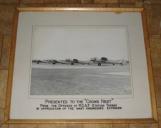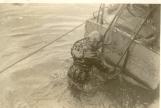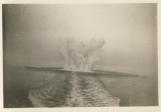14
US Navy Blimp over ConvoyCirca 1943
St. John's, Newfoundland, Canada
 Credits:
Credits:Herbert Roberts Collection
2007-2008 Album, Crow's Nest
15
The Military and Air Force in BotwoodCirca 1940
St. John's, Newfoundland, Canada
 Credits:
Credits:Jacquey Ryan
Robert Innes
16
After about three or four attempts to get into the army I finally got in, in 1941. My name is Bob Innes and my regimental # is F707 in the Royal Canadian Army Core. Royal Canadian Army Service Core supplied all the army and Air force troops in that particular region in fact the Royal Canadian Army Service Core did that all over Newfoundland We had 5 depots in Newfoundland, warehouses, and we supplied all the food and gasoline and transports for the attached forces that was the job of the Royal Canadian Service Army Core, it looked after the Air force and the Army for food stocks including the regiments and everything in the area. The navy had their own services we didn't have to do anything with the navy. So I went down to Botwood and they had an old warehouse and we were stationed with the army. They had an old warehouse with refrigeration and basically I went into the office and in a couple of months they had a couple of freights and within 6 months I was the army Sergeant in charge of that particular depot, distributing the food supplies bringing in the food supplies, to the air force messes to the army regiments and the attached services in the area. So I was at that for I think about a year and a half almost two years in Botwood, during which time it was interesting because the air force was stationed there as well. There was an air base with the RAF and the RCAF and I'm not to sure how many PBY's, surveillance planes, they had there but they had quite a few probably 6 or 8 or maybe a dozen planes and they did surveillance over the Atlantic, checking for U Boats and so on and that was the main job of the Air Force. As well transatlantic flights had started in 1939 ,with the Caledonia, the British Flying Boat and also the American Clippers and Botwood was the base for the transatlantic, they flew across from Ireland to Newfoundland. It was interesting, they had to be refueled and looked after, housed if they stayed overnight and the Air Force that was the Air Force's duty and the army of course built a special chalet to handle the VIP's. I had seen Churchill arrive in Botwood and come off the ramp and come up to the officer's mess, leading, about 6 or 8 executives all following him behind and on his way up to the barracks, the officer's mess, he saw two men digging a ditch. He went over and spoke to them, he was a minute and a half or two minutes with them, and turned around and walked away. He got about ten steps away, turned around, and put up his two V for victory signals with his fingers.17
Royal Canadian Air Force Station Torbay BadgeJune 1944
St. John's, Newfoundland, Canada
 Credits:
Credits:RCAF Photographic Establishment, Photographic Stores Developing and Printing, Ottawa
Jacquey Ryan
John Adams
18
Dec. 18, 2007I joined the RCAF in June 1942, after spending a month in Halifax; I went to St. John's, Newfoundland. I was in a convoy of ships on the Atlantic for four days. I was very seasick and I was in my bunk the whole four days. The officer came down to look at me every day but he did not say anything. A couple of my comrades brought me down a few pieces of hard bread. After we arrived at Torbay the ground rolled around for what seemed like hours.
I was an L.A.C. (Leading Aircraftman) and had been trained at Galt (now Cambridge) Ontario and at Montreal to be a Wireless Operator Ground. My job along with other operators was to receive messages by Morse Code from aircraft on Submarine Patrol. We were on shift as the watch was continuous. We had to remain alert even though waiting for signals could be tedious. Touch typing has come back to me after not using it for over sixty years, and I now use it when I am on the computer.
I especially remember the Knights of Columbus fire in St. John's on December 12, 1942 and the blackouts in St. John's at that time. We did not go to St. John's very often but I do remember walking one day with a bunch of Airmen from the Torbay base to Rawlins Cross in St. John's. There was great fellowship among the RCAF personnel. I remember on day standing in the back of a truck with the other airmen and airwomen on the way to St. John's. One fellow told the girls that I had never been kissed and each of the girls kissed me in turn. I was shy in those days and sometimes had speech difficulties. Role call often was "Hell".
There was not much to do in our spare time and some of my comrades nicknamed me "Horizontal", as I spent considerable time resting in my bunk. In the summertime we sometimes went on picnics. I remember very well one picnic we had on the cliffs of Torbay. I did have a photo of that picnic but it may have been discarded when I moved to the Pavilion.
I did not drink "alcoholic" beverages and I tried not to make an issue of it. Most of the time my comrades accepted it but I remember one occasion when some of the other 17 men in my barrack room were drinking, they tied me with rope to my upper bunk, pried open my mouth and were going to pour scotch liquor down my throat, when the leader at the last moment stopped them. There were no hard feelings. One of my good friends was a quiet as I was when he was sober, but he literally tore the door of its hinges when he had been drinking. He told me that his father was a bootlegger in P.E.I.. I should not have done it but one day,, when we were alone, I pretended that I was going to take a drink and he begged me not to start.
There were no TV's of course in those days and although there were radios, we did not have one in our barracks. The nightly entertainment was a movie (free) and I usually went each night. My only indulgence was a 10 cent chocolate bar each day so I was able to have a considerable part of my monthly pay $60.00. I soon became a banker to more free spending friends, no interest charged. I used to attend church services every Sunday. I was not too happy when one of my comrades came to me and said the Padre did certain things and why did I not do them, but I always stood my ground and was my own man. Later in civilian life, (about 20 years later), a young man in the office asked me why I did not follow one of the latest trends and (which is not true) I replied that "I do not follow trends, I set them". He did not know what to say and he walked away.
I remember one Christmas during the two years I was in Torbay, I was one of four airmen invited on Christmas Day to a home in St. John's, where we enjoyed a fabulous meal. The lady of the house rang a small bell that she held in her hand and servants dressed on uniform answered. If I remember correctly the name may have been "Soper", but I am not sure. It would be in my diary, but I do not have that diary here with me now. I have kept a diary since the age of thirteen and I will be 87 February 2008. When I die, although they are routine, I hope my diaries are saved.
After serving about two years in Torbay, I was transferred to the RCAF Greenwood, Nova Scotia, where I served in a similar capacity till I was discharged in October, 1945, after the war ended in Europe. One of the ladies in the department was a member of the Ganong family. I know her quite well. I always used to say she was a very "sweet" girl in many ways.
I was only a small link in the chain necessary to win "The Battle of the Atlantic", but every link was necessary to bring victory. We who were young are now old and within a number of years most of us will be gone. Those of us at the Veteran's Pavilion, of the Miller Centre, are fortunate to be cared for by Veterans Affairs Canada through Eastern Health of the Province of Newfoundland and Labrador.
After successfully having a five bypass heart operation in 2004, at the age of 83, my health has improved greatly here and I try to advocate with the governing authorities for those unable to speak for themselves. Every Veteran has a story and many are no longer able to tell their stories. As an example I think of an air gunner I know here who is no longer able to tell his story. What sacrifices he and others have made for their country.
The "Battle of the Atlantic" was one of the major battles on World Was 11. If we had lost it, what would be happening today?"
John Adams
19
RCAF Planes on Runway at Royal Canadian Airforce BaseCirca 1941
Torbay, Newfoundland, Canada
 Credits:
Credits:Herbert Roberts Collection
John Stratton
Jacquey Ryan
20
I'm John Stratton, a retired royal air force officer and I spent nearly 30 years 28 years actually in the Royal Air Force in Britain most of the time, all of the time during the war. After the war I served overseas from Britain that is. I'm a navigator, was a navigator, I still think of myself as a navigator. I spent the war years in bomber command in Britain flying Lancasters, a big marvelous four engine airplane piston engines. I enjoyed what I was doing. Now somebody might poo poo that. I didn't enjoy killing people no, but I enjoyed flying and navigating in particular. It was a challenge, we had no modern equipment all was there, was a handheld sexton, which you converted positions and lines with the stars. Now of course you got radar, we did have a bit of radar at the end of the war, not much. There were three fighting commands in the Royal Air Force, there was bomber command, coastal command and fighter command. These are three fighting commands.in the Air force. I was in bomber command, the Battle of the Atlantic took all the resources of Coastal Command and fighter command of course protected Britain and protected our bombers going into Germany as far as their range would allow them but they couldn't go all the way to the targets that we had but they would go probably halfway and then they would have to come back, then we'd meet them on the way home. But Bomber command I might tell you now, suffered the greatest the Royal Air Force Bomber Command during the war suffered the greatest casualties of the whole war. During the war we had a, when I say we I am talking about the Royal Air Force and when I'm talking about the Royal Air Force I say Royal Air Force, but it wasn't totally Royal Air Force. Royal Air Force squadrons both in Coastal Command and in Bomber Command were composed of Royal Air Force air crew, Royal Canadian Air Force air crew Royal Australian Air Force air crew, and Royal New Zealand and South African forces. We had to cover convoys into Britain from the United States, some from Canada as well but mainly they were from the United States bringing food and war material into Britain. And the same ships that survived that battle, they had to go back for another load from Britain to the United States, or to North America anyway and the Royal Navy and the Royal Canadian Navy, they controlled the Battle of the Atlantic. The British Admiral with his headquarters in Liverpool that's who controlled the Battle of the Atlantic. Anyway the Royal Navy escorted ships right across the Atlantic, east and west or west and east all the way from the United Kingdom to North America. Half way across they were relieved of some of the burden by the RCN, who had much smaller ships, corvettes at the time, was only a small ship, but they did human service, they were handed over to the Royal Canadian Navy but the bulk of the burden stayed with the Royal Navy. In addition to service ships with the Royal Navy and the airplanes being used mostly throughout the battle, not at the beginning, we had very little but started out with Hudsons, twin engine airplanes, they were American and they did human service for a short time until we got larger airplanes. We had Thunderlands, which was a Royal Air Force Airplane, a flying boat actually a four engine flying boat which did absolutely human service and we had American built Catalinas, flying boat twin engine and they were mostly stationed in a lake in Northern Ireland. The Airplanes carried depth charges, all of them, if they managed to get a submarine to the surface or detected one they brought it to the surface with depth charges which were locally known as ash cans. In fact I don't think, I know that the Battle of the Atlantic, had it not been for the Air Force that's the RCAF and RAF, it wouldn't have survived if we didn't have them airplanes or them 2 commands both the Canadian and the British Air Command if they weren't there the Navy couldn't have survived. The German's had packs of submarines and you'd need to see a map of the Atlantic with the German submarines plotted on them, they were operating at the time and they were these packs called Wolfpacks and you might have 7, 8, 9 or 10 submarines in a pack here some there and somewhere else and so on, if one sighted the convoy he'd call the rest of them in and they came in like flies, and if there was no Air Force, the Air force kept the submarines submerged, and they couldn't get to their target and they'd get within reasonable distance but they couldn't get within firing range of them and we would have lost that battle and if we had lost that battle we would have lost the bloody war.21
Diver at WorkCirca 1942
St. John's, Newfoundland, Canada
 Credits:
Credits:Herbert Roberts Collection
2007-2008 Album, Crow's Nest
22
Dropping Depth ChargesJune 1943
St. John's, Newfoundland, Canada
 Credits:
Credits:Patrick Griffiths Collection
2007-2008 Album, Crow's Nest
23
Depth Charges ExplodingCirca 1941
St. John's, Newfoundland, Canada
 Credits:
Credits:Patrick Griffiths Collection
2007-2008 Album, Crow's Nest
24
HMS Mansfield Minesweeping Outside the Narrows1943
St. John's, Newfoundland, Canada
 Credits:
Credits:Patrick Griffiths Collection
2007-2008 Album, Crow's Nest